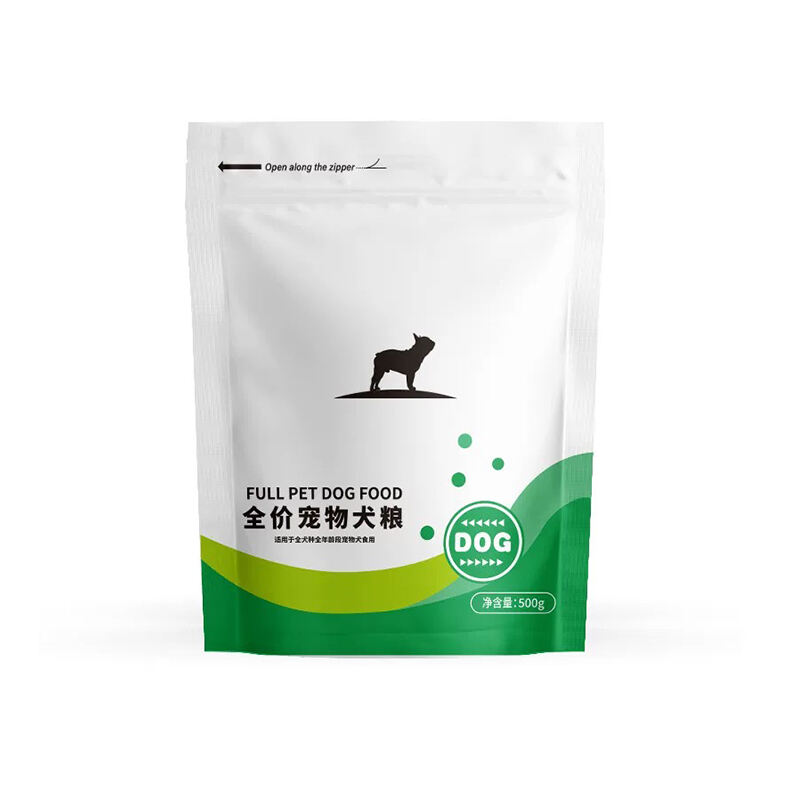บรรจุภัณฑ์ที่เหมาะสมเป็นจุดสำคัญต่อการรักษาคุณค่าทางโภชนาการและความคงทนในการเก็บรักษาของ บรรจุภัณฑ์อาหารสัตว์เลี้ยง . ไขมันจะเกิดการออกซิเดชัน วิตามินเสื่อมสภาพ และเชื้อโรคเพิ่มจำนวนขึ้นเมื่อถูกกระตุ้นด้วยออกซิเจน ความชื้น และสารปนเปื้อน ซึ่งทั้งหมดนี้ส่งผลเสียต่อสุขภาพสัตว์เลี้ยงอย่างมาก บรรจุภัณฑ์แบบกันออกซิเจน บรรจุภัณฑ์อาหารสัตว์เลี้ยง ที่มีประสิทธิภาพสูงสามารถป้องกันปฏิกิริยาเหล่านี้ รักษาความสดและคุณค่าทางโภชนาการตั้งแต่กระบวนการผลิตจนถึงชามอาหารสัตว์เลี้ยง การประมาณการของอุตสาหกรรมระบุว่าบรรจุภัณฑ์คุณภาพสามารถยืดอายุการเก็บรักษาของผลิตภัณฑ์ได้มากถึง 30–40% เมื่อเทียบกับผลิตภัณฑ์ที่ไม่มีการป้องกัน และยังสามารถป้องกันโรคที่เกิดจากอาหารสัตว์เลี้ยงได้อีกด้วย ระบบหลายชั้นเหล่านี้ทำงานเหมือนระบบนิเวศชีวภาพเพื่อรักษาสภาพแวดล้อมภายในให้อยู่ในระดับที่เหมาะสมแม้จะมีการรบกวนจากสภาพแวดล้อมภายนอก
วัสดุกันกันที่ดีจะสามารถกันเชื้อโรค แมลง ไรฝุ่น และสารแพ้ต่างๆ รวมถึงกันน้ำฝนได้อย่างมีประสิทธิภาพ ชั้นเคลือบพอลิเมอร์พิเศษที่ซ้อนทับกันหลายชั้น สามารถป้องกันแบคทีเรียและป้องกันการเคลื่อนย้ายของสารเคมีจากบรรจุภัณฑ์สู่อาหารได้ สภาพแวดล้อมที่ปิดสนิทช่วยป้องกันการปนเปื้อนซ้ำซ้อนในระหว่างการขนส่งและการเก็บรักษา ด้วยชื่อเสียงของผู้ผลิตนี้ ผลการทดสอบอุตสาหกรรมอย่างละเอียดแสดงให้เห็นว่า ชั้นกันกันดังกล่าวสามารถลดการปนเปื้อนของเชื้อโรคได้มากกว่า 98% เมื่อเทียบกับผลิตภัณฑ์ที่มีเพียงชั้นเดียว ซึ่งมีความสำคัญอย่างยิ่งต่อสัตว์เลี้ยงที่มีความเปราะบาง เช่น สัตว์เลี้ยงที่มีอายุมากหรือระบบภูมิคุ้มกันอ่อนแอ
การควบคุมความชื้นช่วยป้องกันไม่ให้อาหารแห้งจับตัวแข็งและเกิดเชื้อรา ตัวบรรจุภัณฑ์ใช้สารดูดความชื้นพิเศษที่ช่วยหยุดการสะสมของความชื้น รักษาระดับความชื้นที่เหมาะสมไว้ที่ 6-8% ในอาหารเม็ดเพื่อคงคุณภาพและความสมบูรณ์ไว้ได้นาน ฟิล์มกันความชื้อช่วยควบคุมระดับความชื้นในผลิตภัณฑ์กึ่งเปียกไว้ที่ระดับต่ำกว่า 0.7 ซึ่งเป็นระดับปลอดภัยสำหรับจุลินทรีย์ การวิจัยแสดงให้เห็นว่า ฉนวนกันความชื้นที่มีคุณภาพสามารถลดการเกิดไมโคท็อกซินได้ถึง 92% และช่วยคงความกรุบกรอบของอาหารแห้งไว้ได้อย่างน้อย 50 วัน
ตัวดูดซับออกซิเจนในตัวดูดซับออกซิเจนแบบแอคทีฟจะทำปฏิกิริยากับออกซิเจนที่เหลืออยู่ในบรรจุภัณฑ์ ซึ่งเป็นตัวเริ่มต้นการเกิดออกซิเดชันของไขมันและทำให้วิตามินสูญเสียไป วัสดุที่ประกอบด้วยสารประกอบเหล็กเหล่านี้จะกักเก็บโมเลกุลของออกซิเจนไว้ภายในไม่กี่ชั่วโมงหลังจากปิดผนึกบรรจุภัณฑ์ ทำให้ความเข้มข้นของออกซิเจนภายในลดลงต่ำกว่า 0.1% กระบวนการนี้ช่วยชะลอการเกิดความเหม็นหืนได้มากถึง 87% เมื่อเทียบกับกากถั่วที่ปราศจากน้ำมันชนิดอื่น ๆ ในตลาด และยังช่วยรักษากรดไขมันจำเป็นเอาไว้ ปัจจุบัน แบรนด์ชั้นนำหลายแบรนด์ได้ใช้การปกป้องแบบเสริมฤทธิ์ร่วมกันระหว่างตัวดูดซับออกซิเจนและกระบวนการเติมไนโตรเจน เพื่อรับประกันความสดใหม่เป็นเวลา 18-24 เดือนโดยไม่ต้องเติมสารกันเสียใด ๆ เพิ่มเติม
การเลือกวัสดุสัมพันธ์โดยตรงกับอายุการใช้งาน คุณภาพทางด้านโภชนาการ และความปลอดภัยของผลิตภัณฑ์อาหารสัตว์เลี้ยง จำเป็นต้องมีความสมดุลที่ดีที่สุดระหว่างคุณสมบัติการกันความชื้น ต้นทุนที่มีประสิทธิภาพ และความยั่งยืน ตลาดประกอบด้วยวัสดุหลักสามประเภท ได้แก่ วัสดุเคลือบหลายชั้น กระดาษคราฟท์ และฟอยล์อลูมิเนียม ซึ่งแต่ละประเภทมีข้อดีในการแปรรูปและการใช้งานที่แตกต่างกัน ขึ้นอยู่กับประเภทของอาหาร ระยะเวลาการเก็บรักษา และระดับความสุกงอมของตลาด
แผ่นลามิเนตหลายชั้น อีกการพัฒนาหนึ่งของแผ่นลามิเนตคือการนำวัสดุหลายชนิด เช่น โพลีโพรพิลีน เอทิลีนไวนิลแอลกอฮอล์ (EVOH) และโพลีเอทิลีนมารวมเข้าด้วยกันเพื่อสร้างแผ่นที่มีคุณสมบัติในการกันออกซิเจน/ความชื้นได้อย่างยอดเยี่ยม ซึ่งเป็นสิ่งจำเป็นอย่างยิ่งในการปกป้องไขมันและวิตามินในผลิตภัณฑ์อาหารที่มีไขมันสูง CARTUSE: วัสดุคอมโพสิตเหล่านี้สามารถยืดอายุการเก็บรักษาให้ยาวขึ้น 30–50% เมื่อเทียบกับพอลิเมอร์ชั้นเดียว เช่น HDPE (พอลิเอทิลีนความหนาแน่นสูง) HDPE สามารถรีไซเคิลได้และมีต้นทุนที่เหมาะสม แต่มีคุณสมบัติการซึมผ่านค่อนข้างสูง ทำให้เกิดการสูญเสียสารอาหาร ถุงลามิเนต (หรือที่เรียกกันว่าลามิเนตฟอยล์) ได้มีการศึกษาแล้วว่าสามารถลดการเกิดออกซิเดชันในอาหารเปียกได้มากถึง 80% เมื่อเทียบกับถุงธรรมดาหรือถุงหลายชั้น ซึ่งคุ้มค่ากับต้นทุนที่สูงกว่าเล็กน้อยสำหรับผลิตภัณฑ์ที่ไวต่อสภาพแวดล้อมที่สุด
กระดาษคราฟท์นำเสนอทางเลือกที่ประหยัดและเป็นมิตรต่อสิ่งแวดล้อมสำหรับบรรจุภัณฑ์อาหารแห้งสำหรับสุนัข โดยเฉพาะสำหรับอาหารแห้งชนิดถุงหนัก (10–25 กิโลกรัม) ซึ่งมีส่วนแบ่งทางการตลาดมากกว่า 40% ความพรุนของกระดาษช่วยป้องกันการกักเก็บความชื้น แม้ว่าจะต้องใช้แผ่นกันความชื้นด้านในเพิ่มเติม (เช่น LDPE - โพลีเอทิลีนความหนาแน่นต่ำ) เพื่อป้องกันความชื้นระหว่างการขนส่ง การรวมกันนี้ช่วยลดต้นทุนวัสดุลง 25% เมื่อเทียบกับบรรจุภัณฑ์พลาสติกทั้งหมด แต่ยังคงความแข็งแรงตามข้อกำหนดสำหรับการใช้งานในระบบจัดเก็บแบบพาเลท ผู้ผลิตที่มุ่งเน้นด้านความยั่งยืนซึ่งต้องการให้แน่ใจว่าสามารถป้องกันการแตกหักในกระบวนการผลิตของตน ทำให้ความต้องการกระดาษคราฟท์เติบโตขึ้น 12% ต่อปี

ฟอยล์อลูมิเนียมสร้างชั้นกันกันที่สมบูรณ์เพื่อปกป้องเนื้อหาภายในถุงจากแสง ออกซิเจน และความชื้น ในขณะที่ถุงฟอยล์อื่น ๆ สามารถกันได้เพียงแสงหรือออกซิเจนเท่านั้น ชั้นกันกันนี้ช่วยป้องกันการเสียหายจากความหืนในอาหารที่มีไขมันสูงหรืออาหารตามสูตรแพทย์ ซึ่งการรักษาคุณค่าทางโภชนาการสำคัญมากกว่าต้นทุน บรรจุภัณฑ์แบบซองเคลือบฟอยล์เป็นผู้นำในกลุ่มอาหารเปียกพรีเมียม (มีส่วนแบ่งการตลาดมากกว่า 80%) และยังยืดอายุการเก็บรักษาให้นานขึ้น 4–6 เดือน เมื่อเทียบกับทางเลือกที่ไม่ใช่ฟอยล์ การลดน้ำหนัก: ความหนาน้อยลงและการใช้งานแบบเจาะรูช่วยลดน้ำหนักของบรรจุภัณฑ์ลง 15% แต่ยังคงคุณสมบัติการกันกันไว้ได้ในถาดพิเศษและซองรีทอร์ด
บรรจุภัณฑ์อาหารสัตว์เลี้ยงที่มีคุณภาพต่ำสามารถเป็นอันตรายต่อความสมบูรณ์ทางโภชนาการและความปลอดภัยของอาหารสัตว์เลี้ยงหลายชนิด ผู้คนได้ลดทอนประสิทธิภาพของชั้นกันซึมในวัสดุคุณภาพต่ำเหล่านี้ ซึ่งส่งผลให้สารอาหารรั่วไหลออกมากขึ้น และก่อให้เกิดสภาพแวดล้อมย่อยที่เกี่ยวข้องกับพิษภัย ในปี 2023 จะเป็นปีที่สมาชิกของสมาพันธ์อุตสาหกรรมอาหารสัตว์เลี้ยงแห่งยุโรป (FEDIAF) ได้ให้ความเห็นในเรื่องนี้ พวกเขาตีความว่าการสูญเสียสารอาหารในผลิตภัณฑ์ที่ใช้บรรจุภัณฑ์คุณภาพต่ำนั้น มีอัตราสูงกว่าผลิตภัณฑ์ที่ใช้บรรจุภัณฑ์ชั้นนำถึง 3.8 เท่า และความเสี่ยงจากไมโคท็อกซิน (mycotoxins) จะสูงขึ้นแบบทวีคูณหากการปิดผนึกไม่มีประสิทธิภาพเต็มที่
การวิจัยของ FEDIAF แสดงให้เห็นว่ากรดไขมันโอเมก้า-3 ลดลง 42 เปอร์เซ็นต์ในปลาและผลิตภัณฑ์ปลาที่บรรจุในถุงพอลิโพรพิลีนชั้นเดียวหลังจากเก็บรักษาไว้เป็นเวลา 6 สัปดาห์ ซึ่งเร็วขึ้นเกือบ 3 เท่าเมื่อเทียบกับการเสื่อมสภาพของผลิตภัณฑ์ที่บรรจุในบรรจุภัณฑ์ที่มีแผ่นอลูมิเนียมบุภายใน อัตราการสูญเสียของพรีมิกซ์วิตามินพบว่าไวมากขึ้น ตัวอย่างเช่น เรตินอล (วิตามิน A) และอัลฟา-โทโคฟีรอล (วิตามิน E) มีการลดลงของความเข้มข้นและประสิทธิภาพตามลำดับ 34% และ 28% ภายใน 90 วันของการเก็บรักษาภายใต้สภาวะมาตรฐาน แนวโน้มเหล่านี้มีความสัมพันธ์สูงกับอัตราการแพร่ผ่านของออกซิเจน (OTR) ของบรรจุภัณฑ์ และวัสดุที่มีค่า OTR เกิน 5 ซีซี/ตารางเมตร/วัน จะส่งผลให้สารอาหารเสื่อมสภาพอย่างถาวร
การศึกษาล่าสุดแสดงให้เห็นว่าบรรจุภัณฑ์ที่มีค่า MVTR สูงกว่า 3 กรัม/ตารางเมตร/วัน จะทำให้ระดับอะฟลาทอกซินในอาหารสัตว์แห้งชนิดเม็ด (kibble) อยู่ในระดับอันตราย (20 ppb) ภายในระยะเวลา 45 วัน โดยข้อมูลจาก FEDIAF ปี 2023 ระบุว่า การล้มเหลวของซิปปิดเปิดเป็นสาเหตุหลักของการปนเปื้อน เนื่องจากซองที่ปิดซิปไม่สนิททำให้สปอร์เชื้อราเข้าไปได้มากกว่าภาชนะที่ปิดด้วยความร้อนถึง 87% บรรจุภัณฑ์ประสิทธิภาพสูงแบบมัลติเลเยอร์สองชั้นช่วยลดความเสี่ยงจากไมโคทอกซิน โดยการควบคุมความชื้นภายในให้อยู่ต่ำกว่า 65%RH ซึ่งเป็นจุดสำคัญในการยับยั้งการเจริญเติบโตของเชื้อรา Aspergillus
เพื่อให้เหมาะสำหรับอาหารสัตว์เลี้ยงที่มีไขมันสูง ระบบกันออกซิเจนเป็นสิ่งจำเป็น เนื่องจากออกซิเดชันของไขมันเป็นสาเหตุหลักของกลิ่นหืน ตามรายงานของ FEDIAF ในปี 2023 พบว่า การเสื่อมสภาพของไขมันในบรรจุภัณฑ์มาตรฐานเร็วขึ้นถึง 300% เมื่อเทียบกับบรรจุภัณฑ์ที่ดูดซับออกซิเจน ทางออกที่ดีที่สุดคือ การใช้ชั้นวัสดุเอทิลีน-วินิลแอลกอฮอล์ (EVOH) ร่วมกับการพ่นไนโตรเจนเพื่อควบคุมปริมาณออกซิเจนที่เหลืออยู่ให้ต่ำกว่า 0.5% ผู้ผลิตชั้นนำในปัจจุบันยังได้เริ่มติดตั้งเซ็นเซอร์ตรวจจับออกซิเจนเข้าไปในถุงบรรจุภัณฑ์โดยตรง ซึ่งมีรายงานว่าช่วยลดปัญหาคุณภาพลงได้ถึง 92% ในระหว่างการทดลอง
ผลิตภัณฑ์ที่ผ่านกระบวนการอบแห้งแบบแช่แข็งต้องการการซึมผ่านของความชื้นต่ำกว่า 1% เพื่อรักษาเนื้อสัมผัสและคุณค่าทางโภชนาการ วัสดุลามิเนตหลายชั้นที่มีฟอยล์อลูมิเนียมหรือพอลิเอสเตอร์เคลือบโลหะให้อัตราการซึมผ่านของไอน้ำ (WVTR) ต่ำกว่า 0.05 กรัม/ตารางเมตร/วัน – ซึ่งมีความสำคัญเนื่องจากส่วนผสมที่ดูดซับความชื้นได้ดีจะดูดซับความชื้นในสภาพแวดล้อมเร็วกว่าอาหารเม็ดถึง 8 เท่า การใช้ซิลิกาเจลแบบซองดูดความชื้นร่วมกับการปิดผนึกแบบอากาศแน่นเพิ่มอายุการเก็บรักษาได้มากขึ้น 40% เมื่อเทียบกับการใช้ซิปแบบปิดเปิดได้เพียงอย่างเดียว
การควบคุมกิจกรรมของน้ำ (aW) ในช่วงระหว่าง 0.6–0.85 จำเป็นต้องมีการป้องกันสิ่งปนเปื้อนจากภายนอกอย่างแม่นยำ:
ข้อมูลจากอุตสาหกรรมแสดงให้เห็นว่าการใช้โครงสร้างไนลอน/พอลิเอทิลีนเทเรฟทาเลต (PET) 7 ชั้นสามารถลดการเกิดเชื้อราลง 79% เมื่อเทียบกับถุงมาตรฐาน 3 ชั้น การทดสอบความสมบูรณ์ของรอยปิดผนึกอย่างเข้มงวดจะช่วยป้องกันการเปลี่ยนแปลงของความชื้นที่เป็นสาเหตุของการเจริญเติบโตของเชื้อโรค
อุตสาหกรรมอาหารสัตว์เลี้ยงกำลังนำโซลูชันบรรจุภัณฑ์ที่ยั่งยืนและสร้างสรรค์มาใช้เพื่อลดผลกระทบต่อสิ่งแวดล้อม ขณะเดียวกันก็รักษามาตรฐานของผลิตภัณฑ์ไว้ ความก้าวหน้าเหล่านี้สามารถตอบโจทย์ประเด็นสำคัญเกี่ยวกับการลดขยะ การใช้พลังงานอย่างมีประสิทธิภาพ และการนำวัสดุมาใช้ซ้ำ ซึ่งไม่กระทบต่อสมบัติการป้องกันหรืออายุการเก็บรักษาของผลิตภัณฑ์
ฟิล์มย่อยสลายได้ที่สามารถนำไปทำปุ๋ยหมักได้จากพอลิเมอร์ที่ผลิตจากพืช เช่น PLA (กรดโพลีแลคติก) สามารถนำไปทำปุ๋ยหมักได้ แต่ยังมีข้อท้าทายในเรื่องสมบัติการป้องกันความชื้นและออกซิเจน ตามรายงานวัสดุนวัตกรรมปี 2016 ระบุว่า แม้ว่าฟิล์มที่นำไปทำปุ๋ยหมักได้จะย่อยสลายได้ภายใน 180 วันภายใต้เงื่อนไขอุตสาหกรรม แต่อัตราการซึมผ่านของออกซิเจนยังสูงกว่าพลาสติกทั่วไปถึง 25 เปอร์เซ็นต์ ในขณะเดียวกัน ผู้ผลิตก็พยายามแก้ไขข้อจำกัดเหล่านี้โดยการรวมชั้นวัสดุที่ย่อยสลายได้เข้ากับเคลือบผิวด้วยขี้ผึ้งบางๆ ซึ่งช่วยให้อายุการเก็บอาหารแห้งอยู่ได้นานถึง 18 เดือน
| คุณสมบัติ | ฟิล์มย่อยสลายได้ | พลาสติกแบบดั้งเดิม |
|---|---|---|
| ระยะเวลาการย่อยสลาย | 6–12 เดือน | 450+ ปี |
| อัตราการแพร่ของออกซิเจน | 25 ซีซี/ตารางเมตร/ต่อวัน | 18 ซีซี/ตารางเมตร/ต่อวัน |
บรรจุภัณฑ์ที่รีไซเคิลได้ทำจากวัสดุชนิดเดียวปัจจุบันคิดเป็น 34% ของการออกแบบบรรจุภัณฑ์อาหารสัตว์เลี้ยงใหม่ เพิ่มขึ้นจาก 12% ในปี 2020 (รายงานความสามารถในการรีไซเคิลของบรรจุภัณฑ์ 2025) โครงสร้างพอลิเอทิลีนชั้นเดียวเหล่านี้ใช้แทนอลูมิเนียมและวัสดุหลายชั้นที่เคลือบรวมกัน ช่วยให้สามารถนำกลับมาใช้ใหม่ในระบบปิดได้ แม้ว่ารุ่นแรกจะมีปัญหาเรื่องกันไขมันไม่ได้ แต่สารเคลือบใหม่สามารถกันไขมันได้ถึง 99% สำหรับอาหารที่มีไขมันสูง ส่งผลให้ขยายตัวในกลุ่มผลิตภัณฑ์ขนมพรีเมียม
ผู้ผลิตบรรจุภัณฑ์อาหารสัตว์เลี้ยงกำลังลดการปล่อยคาร์บอนด้วยการใช้สถานที่ผลิตที่ใช้พลังงานแสงอาทิตย์และหมึกที่ทำจากวัตถุดิบชีวภาพ ผู้ผลิตฟิล์มในยุโรปมากกว่า 60% ได้รับการรับรองความเป็นกลางทางคาร์บอนแล้ว โดยนำของเสียจากการเกษตรมาใช้ในกระบวนการผลิตฟิล์ม การศึกษาวิเคราะห์วงจรชีวิต (LCA) ในปี 2023 แสดงให้เห็นว่าวิธีการเหล่านี้สามารถลดการปล่อยก๊าซเรือนกระจกในห่วงโซ่อุปทานได้ 41% เมื่อเทียบกับกระบวนการทั่วไป ในขณะที่ยังคงอัตราการซึมผ่านของความชื้น (Moisture Vapor Transmission Rates) ไว้ที่ 0.8 g/m²/day ที่อุณหภูมิ 130°C โดยใช้อุณหภูมิการผลิตที่เหมาะสม
ซิปปิดผนึกสำหรับอาหารสัตว์เลี้ยงจะต้องผ่านการทดสอบที่เข้มงวด เพื่อทดสอบความสามารถในการปิดผนึกหลังจากใช้งานซ้ำหลายครั้ง มาตรฐานอุตสาหกรรมทั่วไปเลียนแบบการใช้งานของผู้บริโภค โดยทำให้หน่วยผลิตภัณฑ์ผ่านการเปิด/ปิดมากกว่า 30 รอบภายใต้อุณหภูมิและความชื้นที่แตกต่างกัน ข้อกำหนดด้านประสิทธิภาพนั้นขึ้นอยู่กับความแข็งแรงในการยึดติดของซิป (แรงลอกขั้นต่ำ 5 นิวตัน/15 มม.) และมาตรฐานการรั่วซึม การทดสอบการเก่าเร่งช่วยยืนยันการทำงานของอุปกรณ์หลังจากผ่านการจำลองอายุการเก็บรักษาไปแล้ว 12 เดือน (หรือมากกว่า) การทดสอบเหล่านี้ช่วยให้บรรจุภัณฑ์สามารถทนต่อการใช้งานในบ้านเรือนได้จริง และรักษาคุณสมบัติการป้องกันระหว่างการให้อาหาร ซึ่งเป็นสิ่งสำคัญในการรักษาคุณภาพของอาหารในบรรจุภัณฑ์ที่สามารถปิดซ้ำได้
การป้องกันการแก้ไขหรือเปิดบรรจุภัณฑ์อาหารสัตว์เลี้ยงระดับพรีเมียมนั้น ทำได้โดยการใช้โครงสร้างหลายชั้น แถบฉีกทิ้ง แผ่นรอง และการออกแบบฝาปิดสิทธิบัตรร่วมกัน ระบบป้องกันการแกะกล่องมีตัวชี้วัดการเปิดหรือทำลายที่มองเห็นได้ เพื่อแสดงหลักฐานการแก้ไขบรรจุภัณฑ์ และให้การป้องกันการปนเปื้อนที่อาจเกิดขึ้น ซึ่งสอดคล้องกับพระราชบัญญัติความปลอดภัยอาหารสมัยใหม่ (FSMA) ระบบระดับสูง เช่น หมึกกันปลอม เทคโนโลยีโฮโลแกรม และกาวปิดกล่องที่มีความไวต่อแรงดันเพื่อใช้ในการตรวจสอบทางนิติวิทยาศาสตร์ อาจถูกรวมเข้าไว้ภายในระบบด้วย คุณสมบัติเหล่านี้ช่วยปกป้องความสมบูรณ์ของผลิตภัณฑ์ระหว่างการขนส่งและการจัดแสดงเพิ่มเติม รวมถึงสร้างความมั่นใจให้แก่เจ้าของสัตว์เลี้ยงว่าเนื้อหาทางโภชนาการยังไม่ถูกเปลี่ยนแปลงก่อนการให้อาหารครั้งแรก
บรรจุภัณฑ์มีบทบาทสำคัญในการรักษาสารอาหาร รสชาติ และความปลอดภัยของอาหารสัตว์เลี้ยง โดยปกป้องอาหารจากออกซิเจน ความชื้น และสารปนเปื้อน ช่วยยืดอายุการเก็บรักษา และป้องกันการเกิดโรคที่มากับอาหาร
ใช่ วัสดุบรรจุภัณฑ์คุณภาพสูงถูกออกแบบมาเพื่อกันออกซิเจนและมอยส์เจอร์ ซึ่งเป็นสาเหตุหลักของการเสื่อมสภาพของสารอาหาร บรรจุภัณฑ์ที่มีประสิทธิภาพสามารถชะลอการเกิดออกซิเดชัน และรักษาคุณค่าทางโภชนาการของอาหารสัตว์เลี้ยงไว้ได้
วัสดุที่นิยมใช้ ได้แก่ แผ่นลามิเนตหลายชั้น ฟอยล์อลูมิเนียม และกระดาษคราฟต์ แต่ละชนิดมีข้อดีที่แตกต่างกัน ขึ้นอยู่กับประเภทของอาหาร ระยะเวลาการเก็บรักษา และความต้องการของตลาด
ใช่ อุตสาหกรรมนี้กำลังมุ่งไปที่ทางเลือกที่ยั่งยืน เช่น ฟิล์มที่ย่อยสลายได้ทางชีวภาพ ซองบรรจุที่นำกลับมารีไซเคิลได้ และกระบวนการผลิตที่เป็นกลางทางคาร์บอน เพื่อลดผลกระทบต่อสิ่งแวดล้อม
บรรจุภัณฑ์แต่ละประเภทถูกออกแบบมาโดยเฉพาะเพื่อรองรับอาหารสัตว์เลี้ยงที่แตกต่างกัน เช่น อาหารที่มีไขมันสูง อาหารแช่แข็ง หรืออาหารกึ่งเปียก เพื่อให้เกิดการรักษาคุณภาพและอายุการเก็บรักษาที่เหมาะสมที่สุด